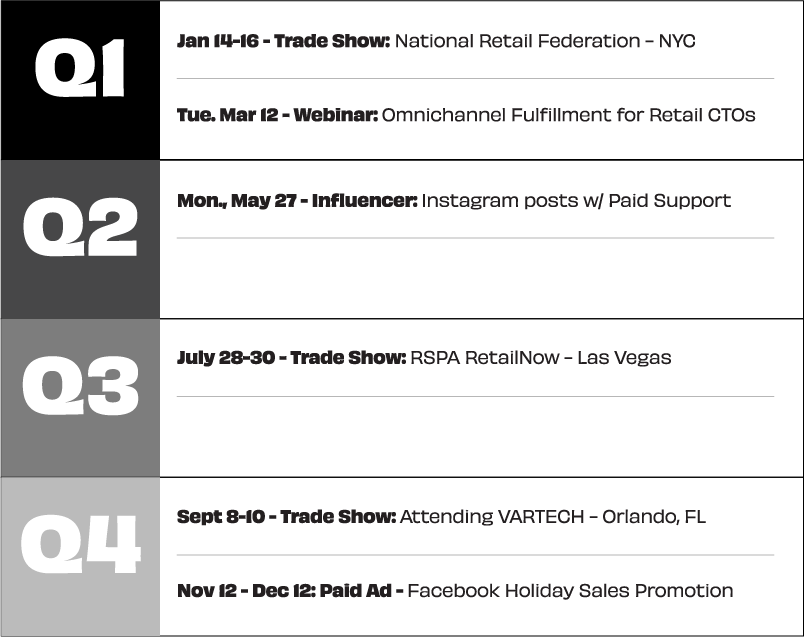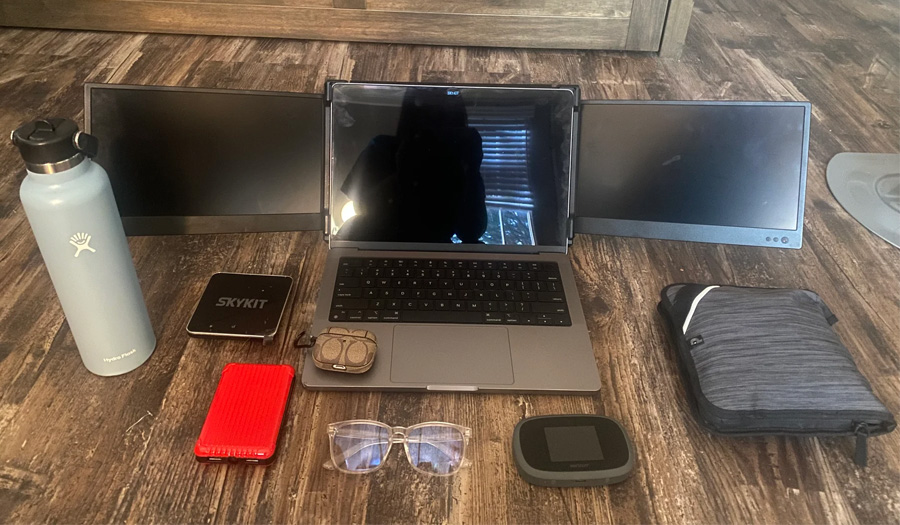I’ve been on dozens of Zoom calls with small business owners in the IT and software space to talk marketing.
I can hardly ask, “Can you see my screen?” before someone on the line asks about ROI.
If it were my money, I’d ask the same thing. They’d be fools not to ask.
But B2B technology solutions don’t convert like consumer products. Hence, the ability to see a direct correlation between dollars spent on things like content, paid advertising, or in-person/online events just isn’t as straightforward as we’d all like it to be.
Does that mean you should sit back and wait for prospects to find you?
I don’t think you’d have tapped in to read this article if that was your stance.
Measuring marketing in a B2B environment requires more art than science. For example: are we increasing the number of people who know who we are and what problems we solve? Does our website traffic show a clear upward trend? Are we seeing a higher number of inbound inquiries? When we publish content, does our intended audience react, or do we hear crickets? When we host in-person events, do the attendees leave with a better impression of us than before, and do they help to increase deal velocity?
For marketing to impact your business meaningfully, you must commit personnel and funding. How you align those resources is up to you, but in this article, I’ll recommend areas to invest in and give an idea of what a sound marketing investment looks like based on your revenue or goals.
Establishing a Budget
You can’t make a plan without having a rough idea of what you’ll spend. Prevailing wisdom says that businesses that aren’t yet known by name and reputation in their market should invest more aggressively than businesses that have established awareness within their target demographic.
Depending on who you trust, it's suggested that you spend between 6 to 12% of your gross revenue on marketing. Only you and your leadership team can decide how aggressively or conservatively you should spend based on your growth goals.
Example budget ranges based on revenue
| Gross Revenue | 6% | 9% | 12% |
| $1M | $60k | $90k | $120k |
| $5M | $90k | $180k | $240k |
| $10M | $600k | $900k | $1.2M |
Many SMBs in the IT solution space treat marketing as a frivolity. They often have out-of-date websites and lack content assets such as video case studies, infographics, eBooks, and other interactive content that larger, better-established businesses have in place.
They have dormant or non-existent social media profiles. Their content may or may not appear on the first page of YouTube or Google search results pages. These companies are talking to marketers like me, trying to determine how they’ll bring in their next ten customers.
If making a meaningful investment into marketing is a new frontier for your business, I would caution against going too wide too soon. Jump in with both feet, but stay focused in key areas until you gain traction and begin to see positive signals.
What to Budget For
Personnel
If you don’t already have at least one full-time marketing resource, it should be a top priority before considering any of the investments I suggest in this article. Marketing firms can do good work, but that work comes at a premium, and unless you’re paying big bucks, they aren’t thinking about your business when you’re not paying them to work on a specific project.
My advice is to hire someone who can create. Marketing has always been about attention, and in 2024 and beyond, attention is being traded online in places like YouTube, LinkedIn, Facebook, Instagram, and TikTok. In response, your business should be publishing in the one or two channels that your audience hangs out in.
Your one-man/woman army marketing person could have a design/media background and writing skills. They could also be a writer with social media experience who is comfortable creating graphics in Canva. If you have the luxury of adding multiple marketing resources, hiring a strategy or operations person is ideal, but if you can only have one? Make sure it’s someone who can publish messages to the market without outside help.
Channels and Techniques
Here is a non-exhaustive list of things you could do to market your business:
- Organic Content/Search Marketing (SEO, YouTube content, social media, earned PR)
- Paid Search Advertising, also known as SEM (Search Engine Marketing) or PPC (Pay-per-click)
- In-person events and Prospect Dinners
- Online events; Webinars
- Influencer marketing
- Podcast marketing
- Paid Social Advertising on channels like Facebook, Instagram, TikTok, X, YouTube, or Linkedin
- Telemarketing
- Direct (Physical) Mail
- Billboards
- Print advertising in trade magazines
If your company is still working to establish a marketing function, I suggest honing in on two of these techniques or channels. Organic content and search optimization is a no-brainer first step.
Ensure your company appears in search results not just in Google/Bing but also in YouTube for branded searches. When someone is specifically typing your company or product name into these engines, they should see your results near the top without you having to pay for that placement.
The next move is up to you and depends on your goals and whether your market is local, regional, national, or global.
Local/regional businesses have more to gain from investing in SEM/PPC, billboards, or in-person events.
Companies with national audiences and/or aspirations might make bigger bets on plays like paid social media advertising, influencer marketing, or print ads in trade publications.
Back of the Envelope: Budget Examples
Below is an example of a growth-focused marketing budget for a $1-2M annual revenue company that comes in right around 7-9% of gross revenue:
| Expense | Estimated Cost | Comments |
| Hubspot for Email / CRM | $12,600 | Up to 10,000 contacts |
| Adobe Creative Cloud | $720/yr per license | 1 License |
| Other Software | $2,500 | Notion, Slack, Zapier |
| Trade Show Sponsorships | $12,000 | 2 events + Travel |
| Paid Digital Advertising | $40,000 | Google, FB, IG, LinkedIn, YouTube |
| Video Equipment | $5,000 | Lights, Cameras, Tripods, Mics |
| Website Plugins | $300/yr | |
| Content Creation | $4,000 | Freelance writers/designers |
| Discretionary Spend Bucket | $10,000 | |
| Total | $87,120 |
Initial total budget:
$87,120
Areas where you could trim your budget:
Email Marketing/CRM platform
Hubspot is a premium option that is highly usable, well supported, and well documented—but it’s also priced in line with these conveniences. Many other options could save you up to 50% of the $12,600 in the budget. (But we do love Hubspot!)
Savings: $6,300
Paid advertising
Although paid advertising is a great way to gain awareness for your business quickly, it is costly. First, experiment with your messages and creative content through non-paid methods before adding fuel to the fire with paid advertising efforts. But let’s leave ourselves a little cash to experiment with—let’s call it $6,000.
Savings: $34,000
Total savings: $40,300
Re-allocating your savings:
Generative AI image service
Midjourney is a leading generative AI image creation service that, for $20/mo or $240/yr, will provide your team with visually interesting and unique images for use in your blog, your website, and social media posts.
Spent: $240
Video Production
If you can’t shoot and edit video in-house, you should set some money aside for 2-3 video pieces that you’ll focus on distributing and re-purposing in multiple places (YouTube, TikTok, Instagram, Facebook, website, sales presentations). One of these videos should showcase your company—but in an authentic, show-them-our-soul way instead of a stuffy, corporate way.
The other two should be video case studies that you shoot on-site with local customers, combining interview footage with b-roll footage of your products in action. If you find the right two-person team, $3,200 per shoot should get this done.
Spent: $10,000
Discretionary Spend Bucket
Twelve months is a long time. It’s a good idea to keep a stack of cash on hand for unexpected opportunities or emergency situations. We started with $10,000—so let’s spend some of what we saved on paid advertising and make it $20,000.
Spent: $10,000
Total re-investment: $20,240
Adjusted Total Budget:
| Expense | Estimated Cost | Comments |
| Email Marketing Platform / CRM | $12,600 $6,300 | Up to 10,000 contacts |
| Adobe Creative Cloud | $720/yr per license | 1 License |
| Other Software | $2,500 | Notion, Slack, Zapier |
| Midjourney AI Image Service | $240/yr | |
| Trade Show Sponsorships | $12,000 | 2 events + Travel |
| Paid Digital Advertising | $40,000 $6,000 | Google, FB, IG, LinkedIn, YouTube |
| Video Equipment | $5,000 | Lights, Cameras, Tripods, Mics |
| Video Production | $10,000 | 2-3 Productions + Edits |
| Website Plugins | $300/yr | |
| Content Creation | $4,000 | Freelance writers/designers |
| Discretionary Spend Bucket | $10,000 $20,000 | |
| Total | $100,620 $67,060 |
Adjusted total budget:
$67,060
In summary:
- We downgraded from Hubspot to a lower-tier email/CRM platform
- We slashed our paid advertising budget until we have a better idea of which messages the market is reacting to
- We added a generative AI image service
- We added funding for third-party video production.
We should feel great about this.
Scheduling
I’ll keep this section short and sweet.
Most foundational marketing elements, such as website optimization and articles, organic content creation and distribution on social, and your customer/prospect email program, are "always on" activities you don’t need to schedule.
Activities such as paid social advertising, prospect dinners, influencer marketing, or webinars can and should be scheduled.
The advice here is simple: shoot for one big moment each quarter and build enough time to be prepared when those moments come.
Example schedule
It’s important to note that as your team grows and your marketing becomes more sophisticated, you may have paid advertising such as SEM/PPC, Facebook ads, or YouTube pre-roll ads running for large swaths of the year.
But to start, keep things simple and understand that things will likely change, and that’s OK.
Measurement and KPIs
At the beginning of this article, we said that as B2B businesses, it’s tough to draw a straight line between the dollars we spend running ads, hosting events, or publishing content and the resulting sales.
With that said, we still need to assess whether our marketing activities are making an impact.
What to optimize for and measure based on marketing technique
| Technique | Goals | Measurement |
| Social content (non-paid, organic) | Educating and providing value at scale | Post reactions, follower growth |
| Website content/optimization | Get discovered in search, optimize on-site conversion paths | Organic web traffic and inbound leads |
| Prospect Dinners | Advance/Close deals | Sales velocity compared with the average time to close |
| Influencer/podcast marketing | Brand Awareness | Increase in organic search traffic and social followers |
| Online events/webinars | Build pipeline with prospects and loyalty with current customers | Registrants, attendees, and sales calls booked |
| Direct (Physical) Mail | Awareness/Leads | Web traffic to a campaign-specific landing page, phone calls attributed to mailer |
| Paid Social Advertising | Reach new prospects, educate about your products/solutions | Followers, website visits, engagement on ads |
To many, brand awareness is a bad word because it isn’t sales conversions. If there were a way for a business to go from unknown in their market to converting new customers in a single step, we’d all be doing it. But unless you’re selling an ultra-commoditized product on price alone—people aren’t going to buy from you the moment they become aware of your company.
Brand awareness isn’t purely about people recognizing your company’s name and logo. We can be educating and influencing buyers at the same time we’re introducing our company. Brand and solution awareness is a critical foundational step in generating demand. Keep that in mind when you’re plotting your marketing mix.
In Summary
- ROI is not going to be crystal clear, but that can’t keep you from promoting your business to new potential buyers
- Marketing budget (not including headcount) should land somewhere between 6-12% of revenue
- When hiring a dedicated marketing resource, look for a resource who can create and publish content
- If you’re working to establish a marketing function—pick 2-3 techniques, invest significantly, and stay focused until you gain traction
- Save some budget for discretionary spend and unforeseen opportunities
- Don’t overthink scheduling—some things are constant, while others require advanced planning. Plan for 2-3 lightning strike moments and put everything you’ve got behind them








